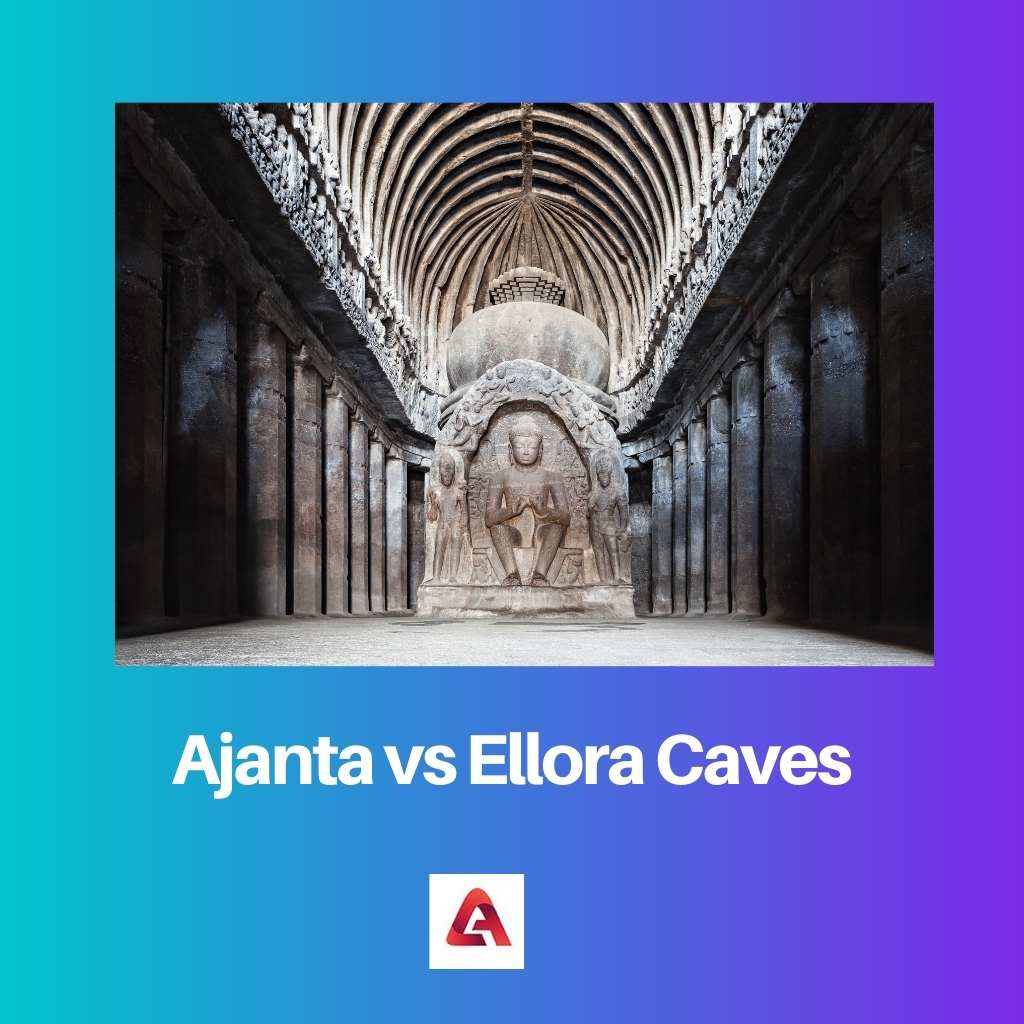We all have been confused in an enthusiastic way in deciding where to go for summer vacation keeping in mind our budgets, time, travel expenses, and finally fun consumed places.
Here there are the best and cheap beautiful architectural places, Ajanta and Ellora caves are located near distances but vary in numerous parameters.
Key Takeaways
- The Ajanta Caves are a collection of Buddhist rock-cut temples in Maharashtra, India, famous for their ancient paintings and sculptures.
- The Ellora Caves are a series of 34 rock-cut temples in Maharashtra, representing Buddhist, Hindu, and Jain religious art.
- The Ajanta Caves date back to the 2nd century BCE. The Ellora Caves were carved between the 5th and 10th centuries CE.
Ajanta vs Ellora Caves
The difference between Ajanta and Ellora caves is that Ajanta caves reflect the architecture of only Buddhism religion. On the other hand, Ellora caves reflect the architecture of other religions like Hinduism, Jainism, and also Buddhism. Both these caves are located near distances and constructed in ancient times during the second and sixth centuries.

Ajanta Caves is a group of 30 caves of different sizes located in the narrow hill called Waghora in Maharastra. Inside these caves, impressive paintings and scriptures are about the religions that existed during ancient times.
They also represent stories of how human beings survived in the past and how transactions happened without money.
Ellora caves are bigger caves consisting of 100 caves. Out of which, only 34 are open for visitors. They are similar to Ajanta caves representing religions and people’s lives through scriptures and paintings.
These caves also have temples inside them. The Lord Shiva temple is famous in these caves and is built perfectly as a chariot-shaped monument. This monument was dedicated to Hinduism for Lord Shiva.
Comparison Table
| Parameters of Comparison | Ajanta Caves | Ellora Caves |
|---|---|---|
| Location | Ajanta is located outside the village named Ajintha, near the Aurangabad district of Maharashtra. | Ellora caves are located thirty kilometers from North West of the Aurangabad district of Maharashtra. |
| Caves | There are 30 caves with 29 open for the public. | There are 100 caves with 34 open for the public. |
| Religions | The religion they depict is only Buddhism. | The religions they depict are Buddhism, Hinduism, and Jainism. |
| Tourists places | They have paintings, architecture, and sculptures. | They have architecture, a few temples, and sculptures. |
| Time period | They are constructed during the 2nd century. | They are constructed during the 6th century. |
What is Ajanta Caves?
Ajanta caves are a cluster of 30 caves of different sizes constructed from the 2nd century BC to the 6th century AD. They are located in the narrow hill called Waghora, outside the village named Ajintha, near the Aurangabad district of Maharashtra.
They depict paintings and scriptures about the religions and lifestyles of people who lived during the older times.
There are 30 caves inside Ajanta but only 29 caves are open to the public for visiting as one of these caves is still under the construction process.
The architecture of Ajanta caves reflects only the Buddhism religion and does not depict any other religions. The beauty of Ajanta caves lies in the impressive paintings about the Buddhism religion and the atmosphere.
There are paintings scripted on rock-cut sculptures. It is one of the finest and oldest arts of India. The most famous cave of Ajanta is cave 1.
It has paintings and scenes depicting the life of Buddha. All the devotees of Buddha are attracted to this cave. All the life-meaning messages of Buddha are scripted and written on the cave walls.
Hence, Ajanta caves are one of the attractive tourists places in Maharastra that are filled with beautiful architecture. People all over the world visit these places to worship Buddha and his life.

What is Ellora Caves?
Ellora caves are a cluster of 100 caves of different sizes constructed from the 6th century AD to the 10th century AD. They are located close to Ajanta caves, thirty kilometers from North West of the Aurangabad district of Maharashtra.
They depict paintings and scriptures about the religions, temples of Lord Shiva, and other gods.
There are 100 caves inside Ajanta but only 34 caves are open to the public for visiting. The architecture of Ajanta caves reflects numerous religions that existed in the ancient period.
They mainly depict Buddhism, Hinduism, and Jainism. The beauty of Ellora caves lies in the impressive paintings and temples of Lord Shiva and Kailashnath temple.
The Ellora caves are dedicated to Hinduism more than other religions. They also worship Buddhism. Ellora has less number of Buddhist caves as compared to Ajanta caves. Cave 10 of the Ellora caves are dedicated to only Chaitya.
There are a few more caves dedicated to Viharas. The patronage was the Rashtrakutas, Kalachuris, Chalukyas, and the Yadavas.
The main attraction of the Ellora caves is the Kailashnath temple. Numerous people around the world visit this temple. Hence, the Ellora caves are one of the beautiful places to visit in Maharastra.

Main Differences Between Ajanta and Ellora Caves
- Ajanta caves are outside the village Ajintha while Ellora is situated thirty kilometers from Aurangabad. Both are located in Maharastra.
- There are 30 caves in Ajanta while there are 100 caves in Ellora. Ajanta is comparatively smaller than Ellora caves.
- Ajanta caves focus only on Buddhism religions. On the other hand, Ellora caves depict Buddhism, Hinduism, and Jainism.
- Ajanta caves do not have any temples and have only architecture while Ellora caves have both temples and architecture.
- Ajanta caves are built during the 2nd century while Ellora caves are built during the 6th century. Ajanta caves were built earlier than Ellora caves.

- https://www.researchgate.net/profile/Parag-Mahajani/publication/275830054_Orientation_of_the_caves_in_Ajantha_and_Ellora_The_UNESCO_heritage_sites_of_India/links/554795260cf26a7bf4d96a24/Orientation-of-the-caves-in-Ajantha-and-Ellora-The-UNESCO-heritage-sites-of-India.pdf
- http://openarchive.icomos.org/id/eprint/1957/
